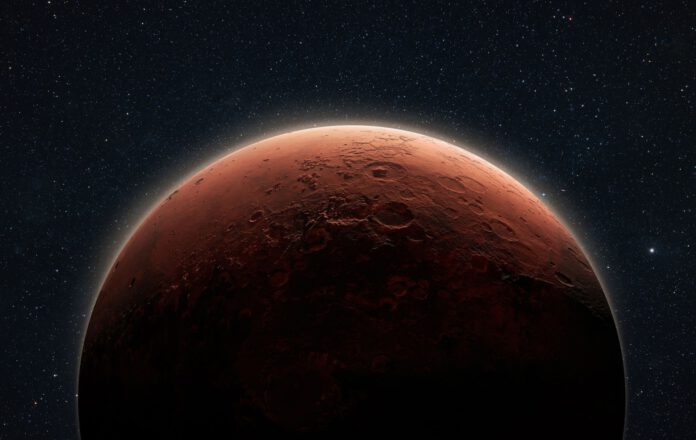
Exciting News
Scientists have discovered a colossal volcano on Mars, surprised to find substantial glacial ice in its proximity. This observation drives researchers to question: could the combination of heat and water have once fostered life in this region?
The new volcano currently goes by the name ‘Noctis volcano’. With a diameter of 450 km and exceeding 9000 meters in height, it is situated west of the Valles Marineris, Mars’ equivalent of the Grand Canyon. Perhaps most intriguing is the idea that this could have been an area where life once evolved. Scientist Pascal Lee, one of the study’s contributors, explains, “Last year we stumbled upon the remnants of a glacier at this location. As we studied its geology, we had an epiphany – we’re dealing with a colossal volcano that has been significantly ravaged.”
Investigations
The researchers unveiled several clues which finally confirmed its volcanic nature. Notably, there is a prominently elevated center where remnants of a caldera, the heart of the volcano where a lava lake once resided, were found. Nonetheless, the most compelling evidence does not concern the volcano itself but its surrounding environment. Co-researcher and team member Sourabh Shubham provides insight: “This Mars region is renowned for its diversity of hydrated minerals. Hence, scientists had speculated the presence of a volcano here for some time. Thus, our discovery does not come as a massive surprise.”
The study has not only uncovered a gigantic volcano. It also shows that the volcano is surrounded by a vast field filled with so-called ‘rootless cones’. These cones are typically caused by steam erupting explosively when a thin layer of warm volcanic material contacts water or a similar icy surface. This ‘icy surface’ was found previously, when Shubham and Lee team discovered glacier remnants in that area. They found sulfates salts, having glacial morphological properties, inside an enormous hollowed-out area soon to be recognized as a volcano. Correspondingly with this new study, researchers thus propose that a colossal glacier may exist beneath the surface.
Space Images and Beyond
For the study, they routinely used space images and 3D models. They have even produced a topographical map with the assistance of NASA’s Mars Global Surveyor. This space probe’s data was later combined with razor-sharp photos from the Mars Reconnaissance Orbiter and Mars Express. The images and models were then meticulously evaluated for the scientists to draw their conclusions.
Extraterrestrial Life
The research findings make a significant impact as the concurrent existence of both a glacier and a volcano in the same area posits the chance of life potentially evolving there. Lee adds, “The discovery of Noctis Volcano is exhilarating due to a multitude of factors. It’s an ancient volcano so eroded that it could perhaps yield data from varying epochs. Also, it has a lengthy chronicle of ice reacting to intense heat. This makes it particularly intriguing for astrobiological studies and searching for extraterrestrial life. Moreover, the glacial ice remains intact, enhancing its appeal for future exploration by humans or robots on Mars.”
While the research solves several mysteries, certain puzzles remain unsolved. It’s clear the volcano was active over a long period and became active early in Mars’s history. However, researchers do not know exactly when the volcano first erupted. Additionally, it is currently unclear whether the volcano is still active and could potentially erupt again. Lastly, the burning question remains whether the volcano, if it has been active for extended periods, turned its surroundings into a habitat where life could originate, assisted by volcanic heat and melting glacial ice.











